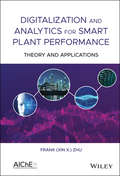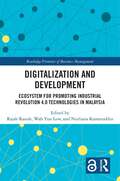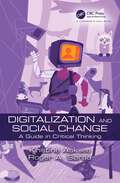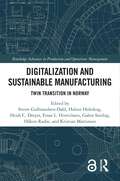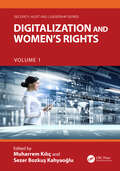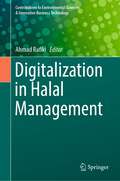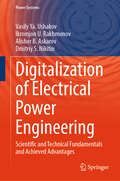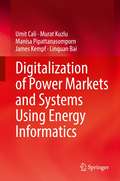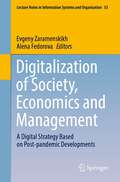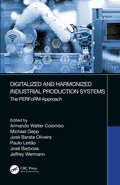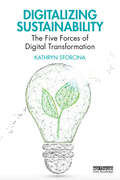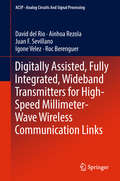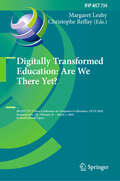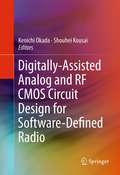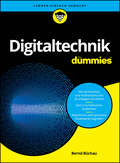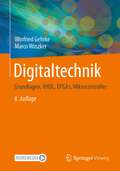- Table View
- List View
Digitalization and Analytics for Smart Plant Performance: Theory and Applications
by Frank (Xin ZhuThis book addresses the topic of integrated digitization of plants on an objective basis and in a holistic manner by sharing data, applying analytics tools and integrating workflows via pertinent examples from industry. It begins with an evaluation of current performance management practices and an overview of the need for a "Connected Plant" via digitalization followed by sections on "Connected Assets: Improve Reliability and Utilization," "Connected Processes: Optimize Performance and Economic Margin " and "Connected People: Digitalizing the Workforce and Workflows and Developing Ownership and Digital Culture," then culminating in a final section entitled "Putting All Together Into an Intelligent Digital Twin Platform for Smart Operations and Demonstrated by Application cases."
Digitalization and Development: Ecosystem for Promoting Industrial Revolution 4.0 Technologies in Malaysia (Routledge Frontiers of Business Management)
by Rajah Rasiah Nurliana Kamaruddin Wah Yun LowThis book examines the diffusion of digitalization and Industry 4.0 technologies in Malaysia by focusing on the ecosystem critical for its expansion. The chapters examine the digital proliferation in major sectors of agriculture, manufacturing, e-commerce and services, as well as the intermediary organizations essential for the orderly performance of socioeconomic agents. The book incisively reviews policy instruments critical for the effective and orderly development of the embedding organizations, and the regulatory framework needed to quicken the appropriation of socioeconomic synergies from digitalization and Industry 4.0 technologies. It highlights the importance of collaboration between government, academic and industry partners, as well as makes key recommendations on how to encourage adoption of IR4.0 technologies in the short- and long-term. This book bridges the concepts and applications of digitalization and Industry 4.0 and will be a must-read for policy makers seeking to quicken the adoption of its technologies.
Digitalization and Social Change: A Guide in Critical Thinking
by Kristine Ask Roger Andre SøraaDigitalization is shaping our everyday lives, yet navigating the changes it entails can feel like trekking into the unknown, where both the possibilities and the consequences are unclear and difficult to grasp. Exploring how digitalization affects all aspects of our lives, from health to culture, this book aims to develop and strengthen the reader’s ability to think critically about such developments. Written in a clear and concise manner with reference to science fiction and pop culture, this book presents potent theoretical perspectives for understanding digitalization processes as societal change. Various exercises are included throughout to encourage readers to critically explore digitalization in their own lives. Replete with illustrations and examples, this book is an accessible guide to digitalization in the modern societal context, appealing to students at the undergraduate level as well as general readership.
Digitalization and Sustainable Manufacturing: Twin Transition in Norway (Routledge Advances in Production and Operations Management)
by Halvor Holtskog Kristian Martinsen Sverre Gulbrandsen-Dahl Heidi C. Dreyer Einar L. Hinrichsen Håkon Raabe Gabor SziebigThe manufacturing industry is facing massive changes driven by digitalization and sustainability. It is being redefined to meet the UN SDGs with the creation of new materials, processes and machinery. The drive for digitalization in order to use resources more effectively and efficiently adds to the complexity of this twin transition. This book presents results from 8 years of research with 15 industry partners, following the transition towards a digitalized industry 4.0 manufacturing and sustainable manufacturing paradigm.The selected chapters demonstrate how globally competitive manufacturing in high-cost countries such as Norway is enabled by AI-supported intelligent and flexible automation and the use of digital twins, as well as human-centred manufacturing. This book describes the interactions in innovative and sustainable organizations and changes in materials, products and processes, digital twins and AI-supported automated manufacturing processes. Supported by case studies and reflections from the manufacturing industry, this book evaluates how the combination of digitalization and sustainability enables competitiveness. With a focus on multi-material products and processes, robust and flexible automation and innovative and sustainable organizations, it provides a multi-disciplinary insight into the challenges and opportunities faced by manufacturing industries over time.This book serves as an ideal reference for researchers, scholars and policymakers in manufacturing, production and operations, with a particular interest in technology and sustainability.
Digitalization and Women's Rights: Volume 1 (Security, Audit and Leadership Series)
by Muharrem Kılıç and Sezer Bozkus̨ KahyaoğluTechnological advancements frequently hinder the progress of women in the business sphere. In our current landscape, the rapid evolution of technology—driven by digital transformation—has created significant barriers to women’s participation. This has given rise to new forms of discrimination that often go unacknowledged and unaddressed. The unfortunate reality is that this issue is sidelined in discussions about the economy and broader implications for employment. We must recognize and confront the unique challenges women face in this technological age, as their exclusion not only impacts them but also stifles innovation and growth in our economy. It is time to advocate for a more inclusive approach that empowers women in the tech world.In this vital context, it is essential to recognize the discrimination and emerging challenges that women will face, although these issues may not have been previously explored in sufficient detail. This work has been thoughtfully created to fill that gap, serving as a crucial reference about these matters. By shedding light on existing gaps in the research, this book promises to enrich future studies and provide invaluable insights for researchers who investigate and evaluate related works. One of the most pressing challenges ahead for women in the rapidly evolving digital landscape is understanding and navigating the economic opportunities available to them. As we enter this new era, women will undergo a transformative journey that demands adaptability and learning in the face of continuous innovation. This work aspires to contribute significantly to these conversations and empower women as they embrace the future.
Digitalization at Siemens
by Tonia Junker David J. CollisProfessor David J. Collis and Research Assistant Tonia Junker (Europe Research Center) prepared this case. It was reviewed and approved before publication by a company designate. Funding for the development of this case was provided by Harvard Business School and not by the company. HBS cases are developed solely as the basis for class discussion. Cases are not intended to serve as endorsements, sources of primary data, or illustrations of effective or ineffective management.
Digitalization in Additive Manufacturing (Springer Tracts in Additive Manufacturing)
by Numan M. Durakbasa Kerim Cetinkaya Pinar Demircioglu Ismail BogrekciThis book features a selection of papers presented at the 8th International Congress on 3D Printing Technologies and Digital Industry 2024 (3D-PTC2024), held from September 6–8, 2024, in Antalya, Türkiye, in a hybrid format. It covers several topics reflecting the dynamic landscape of additive manufacturing and digital innovation. The chapters explore cutting-edge advancements in materials and techniques, alongside practical applications in medical, dental, and industrial realms. Digital design, simulation, and sustainability considerations are presented with discussions on regulatory frameworks and future trends, offering a comprehensive view of this transformative field.
Digitalization in Construction: Recent trends and advances (Spon Research)
by Farzad Pour Rahimian Nashwan Dawood Chansik Park Akeem Pedro Rahat Hussain Mehrtash Soltani Dongmin LeeThis book highlights the latest trends and advances in applications of digital technologies in construction engineering and management. A collection of chapters is presented, explicating how advanced technological solutions can innovatively address challenges and improve outcomes in the construction industry. Promising technologies that are highlighted include digital twins, virtual reality, augmented reality, artificial intelligence, robotics, blockchain, and distributed ledger technologies. The first section presents recent applications of extended reality technologies for construction education and advanced project control. The subsequent chapters explore Artificial Intelligence (AI), blockchain, and BIM-enabled digitalization in construction through a series of case studies, reviews, and technical studies. Innovative technologies and digitalized solutions are proposed for improved design, planning, training, monitoring, inspection, and operations management in Architectural, Engineering and Construction (AEC) contexts. In addition to the technological perspectives and insights presented, pressing issues such as decarbonization, safety, and sustainability in the built environment are also discussed. This book provides foundational knowledge and in-depth technical studies on emerging technologies for students, academics, and industry practitioners. The research demonstrates how the effective use of new technologies can enhance work methods, transform organizational structures, and bring profound advantages to construction project participants.
Digitalization in Halal Management (Contributions to Environmental Sciences & Innovative Business Technology)
by Ahmad RafikiThe book emphasizes the digitalization process in halal management of products and industries, which relate to the comparisons and cases in many countries viewed from an Islamic perspective. It needs a new view of using information technology to achieve wider coverage of promoting halal products as well as to develop the halal industries. A global perspective that consists of experiences from Muslim majority and minority countries will be presented in this book. This topic is also associated with the concepts on Islamic business and management. Islamic business not only focuses on finance/banking, but beyond that Islam teaches all people to do Shariah-compliant transactions or business. The book gives solutions to halal industry through digitalization. Islam has many solutions to be offered, and thus, it is important to reveal and discuss the Islamic way of managing business, including halal management. The book also discusses the halal products and its certifications. This book is intended for stakeholders of different industries, from environmental to food, in the need of digital tools and IT infrastructure.
Digitalization of Electrical Power Engineering: Scientific and Technical Fundamentals and Achieved Advantages (Power Systems)
by Vasily Ya. Ushakov Ikromjon U. Rakhmonov Alisher B. Askarov Dmitriy S. NikitinThis book aims to provide readers with practical knowledge of the fundamentals of the &“digital transition&” concept, tools for designing and managing the operation of smart grids and substations, and critical issues in modernizing the energy sector. The inevitable transformation of the electric power industry is moving toward digitalization, which has taken the form of the concept of "Intelligent (smart) grids" (sometimes called "Digital Transition"). This has required coordinated work not only from the energy industry, but also from other stakeholders (government agencies, private firms, utilities, scientific and educational institutions, etc.) to solve numerous problems that arise during the transition to this advanced technology. It is obvious that the development of new components of energy systems, such as smart meters, monitoring and geolocation equipment, new disaster recovery systems, and energy storage systems, should be supplemented by the creation of the necessary communication infrastructure, modernization of existing network components, implementation of relevant regulations, training of highly qualified personnel. The book covers all the main tasks and ways to solve them for the implementation of this technology. It summarizes materials from numerous monographs, scientific articles, and conference reports discussing these issues.
Digitalization of Power Markets and Systems Using Energy Informatics
by Umit Cali Murat Kuzlu Manisa Pipattanasomporn James Kempf Linquan BaiThe objective of this textbook is to introduce students and professionals to fundamental principles and techniques and emerging technologies in energy informatics and the digitalization of power markets and systems. The book covers such areas as smart grids and artificial intelligence (AI) and distributed ledger technology (DLT), with a focus on information and communication technologies (ICT) deployed to modernize the electric energy infrastructure. It also provides an overview of the smart grid and its main components: smart grid applications at transmission, distribution, and customer level, network requirements with communications technologies, and standards and protocols. In addition, the book addresses emerging technologies and trends in next-generation power systems, i.e., energy informatics, such as digital green shift, energy cyber-physical-social systems (E-CPSS), energy IoT, energy blockchain, and advanced optimization. Future aspects of digitalized power markets and systems will be discussed with real-world energy informatics projects. The book is designed to be a core text in upper-undergraduate and graduate courses such as Introduction to Smart Grids, Digitalization of Power Systems, and Advanced Power System Topics in Energy Informatics.
Digitalization of Society, Economics and Management: A Digital Strategy Based on Post-pandemic Developments (Lecture Notes in Information Systems and Organisation #53)
by Evgeny Zaramenskikh Alena FedorovaThis book gathers the best papers presented at the third conference held by the Russian chapter of the Association for Information Systems (AIS), which took place in December 2021. The book shows the path to digital transformation of organizations and how possible obstacles can be overcome. With contributions from digital experts in both academia and IT and management, it presents practical frameworks and planning tools for new business models. It offers executives at the forefront of strategic initiatives a guide on how to implement key disruptive technologies in their organizations while following an established digital strategy. Overall, the book is relevant for scientists, digital technology users, companies and public institutions.
Digitalized and Harmonized Industrial Production Systems: The PERFoRM Approach
by Armando Walter Colombo Michael Gepp José Barata Paulo Leitao José Barbosa Jeffrey WermannOn the one side, Industrial competitiveness today means shorter product lifecycles, increased product variety, and shorter times to market and customized tangible products and services. To face these challenges, the manufacturing industry is forced to move from traditional management, control, and automation approaches towards industrial cyber-physical systems. On the other side, several emergent engineering approaches and related Information‐Communication‐Control‐Technologies, such as Multi‐Agent-Systems, Service‐Oriented Architecture, Plug‐and‐Produce Systems, Cloud and Fog Technologies, Big Data and Analytics, among others, have been researched during the last years. The confluence of those results with the latest developments in Industrial Digitalization, Systems‐of‐Cyber-Physical-Systems Engineering, Internet‐of‐Things, Internet‐of‐Services, and Industry 4.0 is opening a new broad spectrum of innovation possibilities. The PERFoRM (Production-harmonizEd-Reconfiguration of Flexible Robots and Machinery) approach is one of them. It teaches the reader what it means when production machines and systems are digitalized and migrated into Industrial Cyber-Physical Systems and what happens when they are networked and start collaborating with each other and with the human, using the internet. After a Technology Trend Screening and beyond a comprehensive state-of-the-art analysis about Industrial Digitalization and Industry 4.0-compliant solutions, the book introduces methods, architectures, and technologies applicable in real industrial use cases, explained for a broad audience of researchers, practitioners, and industrialists.
Digitalizing Sustainability: The Five Forces of Digital Transformation
by Kathryn SforcinaDigitalizing Sustainability outlines why ‘business as usual’ isn't working and sets out five Transformational Forces which can be used to innovate and scale sustainability solutions using digital means. This transformation will be powered by a range of digital technologies that have the potential to ideate, propel and scale sustainability solutions in an exponential manner over the next decade. This book introduces the Five Forces of Digital Transformation. These forces all share a common root – they are powered by digital technologies that enable them to operate at the speed and scale that we need to achieve global transformation for people and planet. Working together, these forces help overcome many of the barriers and pitfalls that humanity has faced in trying to achieve sustainability 2.0 and will help you tackle these questions: Why has sustainability 1.0 failed us? What are the bugs and bad code in our operating systems that we must address to have any hope of creating a sustainable civilization? What are the Five Forces of Digital Transformation that will forge a sustainable and resilient future for our people and planet? What are the core priorities going forward for coalitions of the willing to harness these forces for sustainability and resilience? Disruptive and innovative, this book provides readers with a clear path forward to a sustainable digital future. It will be of great interest to anyone interested in the adoption of digital technologies for driving solutions to global sustainability challenges.
Digitally Assisted, Fully Integrated, Wideband Transmitters for High-Speed Millimeter-Wave Wireless Communication Links (Analog Circuits and Signal Processing)
by David Del Rio Ainhoa Rezola Juan F. Sevillano Igone Velez Roc BerenguerThis book presents design methods and considerations for digitally-assisted wideband millimeter-wave transmitters. It addresses comprehensively both RF design and digital implementation simultaneously, in order to design energy- and cost-efficient high-performance transmitters for mm-wave high-speed communications. It covers the complete design flow, from link budget assessment to the transistor-level design of different RF front-end blocks, such as mixers and power amplifiers, presenting different alternatives and discussing the existing trade-offs. The authors also analyze the effect of the imperfections of these blocks in the overall performance, while describing techniques to correct and compensate for them digitally. Well-known techniques are revisited, and some new ones are described, giving examples of their applications and proving them in real integrated circuits.
Digitally Transformed Education: 4th IFIP TC 3 Open Conference on Computers in Education, OCCE 2024, Bournemouth, UK, February 27 – March 1, 2024, Revised Selected Papers (IFIP Advances in Information and Communication Technology #734)
by Margaret Leahy Christophe ReffayThis book constitutes the refereed post-conference proceedings of the 4th IFIP TC 3 Open Conference on Computers in Education, OCCE 2024, held in Bournemouth, UK, during February 27 – March 1, 2024. The 22 full papers and 3 short papers included in this volume were carefully reviewed and selected from 72 submissions. They were organized in topical sections as follows: Digital Education in Schools, Higher Education and Communities; Computing Education in Schools and Higher Education; and Contributions of IFIP TC3 to Digital Education.
Digitally-Assisted Analog and Analog-Assisted Digital IC Design
by Xicheng JiangAchieve enhanced performance with this guide to cutting-edge techniques for digitally-assisted analog and analog-assisted digital integrated circuit design. • Discover how architecture and circuit innovations can deliver improved performance in terms of speed, density, power, and cost • Learn about practical design considerations for high-performance scaled CMOS processes, FinFet devices and architectures, and the implications of FD SOI technology • Get up to speed with established circuit techniques that take advantage of scaled CMOS process technology in analog, digital, RF and SoC designs, including digitally-assisted techniques for data converters, DSP enabled frequency synthesizers, and digital controllers for switching power converters. With detailed descriptions, explanations, and practical advice from leading industry experts, this is an ideal resource for practicing engineers, researchers, and graduate students working in circuit design.
Digitally-Assisted Analog and RF CMOS Circuit Design for Software-Defined Radio
by Shouhei Kousai Kenichi OkadaThis book describes the state-of-the-art in RF, analog, and mixed-signal circuit design for Software Defined Radio (SDR). It synthesizes for analog/RF circuit designers the most important general design approaches to take advantage of the most recent CMOS technology, which can integrate millions of transistors, as well as several real examples from the most recent research results.
Digitaltechnik für Dummies (Für Dummies)
by Bernd BüchauVon den Grundlagen der Boole’schen Algebra bis zur Synthese digitaler Systeme Die Digitaltechnik stellt heute praktisch für alle elektrischen und elektronischen Geräte des täglichen Lebens und in der industriellen Anwendung die Basis dar—deswegen ist sie so wichtig und unverzichtbar. Deshalb ist dieses Gebiet auf möglichst verständliche und vollständige Weise im vorliegenden Lehr- und Übungsbuch behandelt worden. Auch wenn es manchmal kniffelig wird, keine Angst, der Autor führt Sie sicher durch dieses Gebiet zum Ziel, mit fundierten Grundlagen und vielen Beispielen sowie Übungen. Als Interessierter wie auch als Studierender werden Sie mit den vielen Übungen zuverlässig auf die Praxis und anstehende Prüfungen vorbereitet – viel Erfolg. Sie erfahren Was die Digitaltechnik in Theorie und Praxis ist Welche mathematischen Grundlagen Sie benötigen Wie eine Analyse durchgeführt wird Wie eine Synthese einer digitalen Schaltung erfolgt
Digitaltechnik: Grundlagen, VHDL, FPGAs, Mikrocontroller
by Winfried Gehrke Marco WinzkerModerne Digitaltechnik, umfassend und kompakt: Dieses Lehr- und Übungsbuch spannt den Bogen von den Grundlagen der Digitaltechnik über den Entwurf mit VHDL und Komponenten digitaler Systeme bis zu modernen Mikrocontrollern der STM32-Serie.Digitale Grundelemente wie Logikgatter und Flip-FlopsKombinatorische und sequenzielle SchaltungenSchaltungsentwurf und Simulation mit VHDLProgrammierbare Logikbausteine: CPLDs, FPGAsHalbleiterspeicherA/D- und D/A-UmsetzerArchitektur von MikroprozessorenProgrammierung von Arm® CortexTM Mikroprozessoren in C und Assembler32-Bit-Mikrocontroller der STM32-FamilieFunktion und Programmierung von STM32-Peripheriemodulen Die 8. Auflage wurde aktualisiert und die Themenbereiche Mikroprozessoren und Mikrocontroller grundlegend überarbeitet.Zahlreiche Beispiele erleichtern das Verständnis. Viele Übungsaufgaben mit Musterlösungen unterstützen die Lernkontrolle und stehen zu jedem Kapitel zur Verfügung. Ergänzendes Material wird auf der Webseite zum Buch angeboten.Das Buch ist so konzipiert, dass es sowohl als Begleitlektüre von Lehrveranstaltungen als auch für das Selbststudium in den Bereichen Digitaltechnik, Mikrocontroller und Systementwurf geeignet ist.
Digitised Health, Medicine and Risk
by Deborah LuptonA prevailing excitement can be discerned in the medical and public health literature and popular media concerning the apparent ‘disruptive’ or ‘revolutionary’ potential of digital health technologies. Most of the wider social implications are often ignored or glossed over in such accounts. Critical approaches from within the social sciences that take a more measured perspective are important – including those that focus on risk. The contributors to this volume examine various dimensions of risk in the context of digital health. They identify that digital health devices and software offer the ability to configure new forms of risk, in concert with novel responsibilities. The contributions emphasise the sheer volume of detail about very personal and private elements of people’s lives, emotions and bodies that contemporary digital technologies can collect. They show that apps and other internet tools and forums provide opportunities for health and medical risks to be identified, publicised or managed, but also for unvalidated new therapies to be championed. Most of the authors identify the neoliberal ‘soft’ politics of digital health, in which lay people are encouraged (‘nudged’) to engage in practices of identifying and managing health risk in their own interests, and the victim-blaming that may be part of these discourses. This book was originally published as a special issue of Health, Risk and Society.
Digitising Command and Control: A Human Factors and Ergonomics Analysis of Mission Planning and Battlespace Management (Human Factors in Defence)
by Daniel P. Jenkins Neville A. Stanton Guy H. Walker Paul M. Salmon Kirsten M. Revell Laura A. RaffertyThis book presents a human factors and ergonomics evaluation of a digital Mission Planning and Battle-space Management (MP/BM) system. An emphasis was placed on the activities at the Brigade (Bde) and the Battle Group (BG) headquarters (HQ) levels. The analysts distributed their time evenly between these two locations. The human factors team from Brunel University, as part of the HFI DTC, undertook a multi-faceted approach to the investigation, including: - observation of people using the traditional analogue MP/BM processes in the course of their work - cognitive work analysis of the digital MP/BM system - analysis of the tasks and goal structure required by the digital MP/BM - assessment against a usability questionnaire - analysis of the distributed situation awareness - an environmental survey. The book concludes with a summary of the research project's findings and offers many valuable insights. For example, the recommendations for short-term improvements in the current generation of digital MP/BM system address general design improvements, user-interface design improvements, hardware improvements, infrastructure improvements and support improvements. In looking forward to the next generation digital MP/BM systems, general human factors design principles are presented and human factors issues in digitising mission planning are considered.
Digitising Democracy: On Reinventing Democracy in the Digital Era - A Legal, Political and Psychological Perspective
by Volker Boehme-NeßlerThis book argues that in the digital era, a reinvention of democracy is urgently necessary. It discusses the mounting evidence showing that digitalisation is pushing classical parliamentary democracy to its limits, offering examples such as how living in a filter bubble and debating with political bots is profoundly changing democratic communication, making it more emotional, hysterical even, and less rational. It also explores how classical democracy involves long, slow thinking and decision processes, which don’t fit to the ever-increasing speed of the digital world, and examines the technical developments some fear will lead to governance by algorithms.In the digitalised world, democracy no longer functions as it has in the past. This does not mean waving goodbye to democracy – instead we need to reinvent it. How this could work is the central theme of this book.
Digitising the Industry Internet of Things Connecting the Physical, Digital and VirtualWorlds
by Ovidiu Vermesan Peter FriessThis book provides an overview of the current Internet of Things (IoT) landscape, ranging from the research, innovation and development priorities to enabling technologies in a global context. A successful deployment of IoT technologies requires integration on all layers, be it cognitive and semantic aspects, middleware components, services, edge devices/machines and infrastructures. It is intended to be a standalone book in a series that covers the Internet of Things activities of the IERC - Internet of Things European Research Cluster from research to technological innovation, validation and deployment. The book builds on the ideas put forward by the European Research Cluster and the IoT European Platform Initiative (IoT-EPI) and presents global views and state of the art results on the challenges facing the research, innovation, development and deployment of IoT in the next years. The IoT is bridging the physical world with virtual world and requires sound information processing capabilities for the "digital shadows" of these real things. The research and innovation in nanoelectronics, semiconductor, sensors/actuators, communication, analytics technologies, cyber-physical systems, software, swarm intelligent and deep learning systems are essential for the successful deployment of IoT applications. The emergence of IoT platforms with multiple functionalities enables rapid development and lower costs by offering standardised components that can be shared across multiple solutions in many industry verticals. The IoT applications will gradually move from vertical, single purpose solutions to multi-purpose and collaborative applications interacting across industry verticals, organisations and people, being one of the essential paradigms of the digital economy. Many of those applications still have to be identified and involvement of end-users including the creative sector in this innovation is crucial. The IoT applications and deployments as integrated building blocks of the new digital economy are part of the accompanying IoT policy framework to address issues of horizontal nature and common interest (i.e. privacy, end-to-end security, user acceptance, societal, ethical aspects and legal issues) for providing trusted IoT solutions in a coordinated and consolidated manner across the IoT activities and pilots. In this, context IoT ecosystems offer solutions beyond a platform and solve important technical challenges in the different verticals and across verticals. These IoT technology ecosystems are instrumental for the deployment of large pilots and can easily be connected to or build upon the core IoT solutions for different applications in order to expand the system of use and allow new and even unanticipated IoT end uses. Technical topics discussed in the book include: • Introduction• Digitising industry and IoT as key enabler in the new era of Digital Economy• IoT Strategic Research and Innovation Agenda• IoT in the digital industrial context: Digital Single Market• Integration of heterogeneous systems and bridging the virtual, digital and physical worlds• Federated IoT platforms and interoperability• Evolution from intelligent devices to connected systems of systems by adding new layers of cognitive behaviour, artificial intelligence and user interfaces.• Innovation through IoT ecosystems• Trust-based IoT end-to-end security, privacy framework• User acceptance, societal, ethical aspects and legal issues• Internet of Things Applications
Digitization and Manufacturing Performance: An Environmental Perspective
by Chandan Deep Singh Davinder Singh Talwinder SinghThe book provides valuable insights into how modern production strategies can enhance quality, efficiency, and environmental sustainability, ultimately driving profit and competitive advantage in today’s high-tech industry. Today, production strategies are influenced by quality, cost, delivery, innovation, and responsiveness. Firms have traditionally pursued these goals through the adoption of production practices, such as simultaneous engineering, increasing efficiency through the elimination of defects, setup reduction, and worker empowerment. However, recent developments in industry suggest that industry regulators and professional bodies must encourage innovation in a broad range of high-tech production facilities with the environment in mind. The success of the industry depends on production facilities and the competitive advantage that the industry gains due to better quality and reliability. This advantage leads to an increase in sales and the creation of a sound customer base for greater market share, which eventually leads to more profit, growth, and expansion. A firm’s processes must possess operating advantages in the form of competitive priorities to outperform its competitors, keeping in mind its influence on the environment. Digitization and Manufacturing Performance: An Environmental Perspective presents the expectations of industrialists, policymakers, and academics by evaluating the impact of production facilities. Readers will find the book: Discusses emerging technologies and their role in environmental aspects in detail; Provides a comprehensive overview of the latest existing and emerging technologies and their environmental aspects; Justifies social, economic, and technical considerations of these technologies; Explores the relationship between advanced technologies and the environment through in-depth studies. Audience Researchers, scholars, faculty, professionals in research and development, and industrialists in the industrial, production, mechanical, and electronics sectors.
